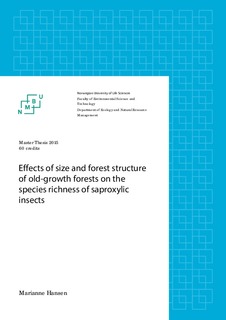| dc.contributor.author | Hansen, Marianne | |
| dc.date.accessioned | 2016-02-18T15:12:36Z | |
| dc.date.available | 2016-02-18T15:12:36Z | |
| dc.date.issued | 2016-02-18 | |
| dc.identifier.uri | http://hdl.handle.net/11250/2379609 | |
| dc.description.abstract | Many saproxylic insects are threatened by extinction, and a decline in the saproxylic species has been observed since the 1800s. The loss of areas of old-growth forest, fragmentation and the decline in volume of dead wood in managed boreal forests, have been found as important reasons for the observed decline.
The purpose of this study was to investigate whether or not the size of old-growth forest fragments affects the species richness of different saproxylic insect groups, and to find what environmental variables best explain the species richness of these different insect groups. Such information is important for further conservation work.
The insects were collected by window traps and by rearing of insects from sporocarps of Fomitopsis pinicola. The collected insects were divided into the different insect groups; saproxylic beetles, fungivorous beetles (a subset of the saproxylic beetles), reared beetles species, parasitoid wasp species and hyperparasitoid wasp species. The parasitoid and hyperparasitoid wasps represented higher trophic level than the other insect groups.
The study showed that the species richness of the saproxylic insect groups was either the same or higher in the small forest fragments, compared to the large forest fragments.
The species richness of each insect groups was best explained by different environmental variables: The number of saproxylic beetle species increased with an increase in volume of dead wood, while at the same time it decreased with an increase in polypore diversity. The species richness of the fungivorous beetle subset increased with the polypore hymenophore area. The number of beetle species was highest in the most decomposed sporocarps, compared to the least decomposed ones. The species richness of parasitoid wasps was higher in decomposition class II sporocarps, compared to decomposition class I sporocarps. The species richness of parasitoid wasps also increased with the number of beetles present in the sporocarps.
It was concluded that large and continuous old-growth forests should be prioritizes in the conservation of threatened saproxylic insects. Forests with a high diversity of dead wood substrates and wood-decomposing fungi supports a high diversity of saproxylic insects, and should also hold a high value for the conservation of saproxylic insects. | nb_NO |
| dc.description.abstract | Mange saproxyle insekter er truet med å dø ut, og en nedgang i disse artene har vært observert siden 1800-tallet. Tap av arealer med gammel skog, fragmentering og nedgangen i mengde død ved i skogbruksområder er noen av grunnene til denne nedgangen. Hensikten med denne studien var å undersøke om størrelse på gammelskogområder har en påvirkning på artsrikheten av ulike grupper av saproxyle insekter, og å finne hvilke miljøvariabler som er viktigst for å beskrive artsrikheten til disse ulike gruppene. Insektene ble samlet inn fra vindusfeller og fra fruktlegemer av Fomitopsis pinicola. De innsamlede insektene ble delt inn i de ulike insektsgruppene; saproxyle biller, soppspisende biller (en undergruppe av de saproxyle billene), klekkede biller, snylteveps og hyperparasitoide snylteveps. Snyltevepsen og de hyperparasitoide snyltevepsene representerte høyere trofiske nivåer enn de øvrige artsgruppene. Studien viste at det var like mange eller flere billearter per arealenhet i de små skogsområdene. I forhold til i de store. Antallet av arter i de ulike insektsgruppene ble best beskrevet ved hjelp av ulike miljøvariables: Antall arter av saproxyle biller økte med mengde død ved, og på samme tid sank med økende polypore diversitet. Antall arter av fungivore biller økte med økende pore-overflate-areal av polypore sopper. Det var flere arter av biller i de sterkest nedbrutte fruktlegemene, i forhold til de minst nedbrutte. Det var flere arter av snylteveps i fruktlegemer i nedbrytningsfase II, sammenlignet med nedbrytningsfase I. Antall arter av snylteveps økte også med mengden av biller til stede i fruktlegemene. Det ble konkludert at store sammenhengende skogsområder av gammel skog burde prioriteres ved videre bevaringstiltak for truede saproxyle insekter. Skogsområder med en høy diversitet av død ved og råtesopp har en høy diversitet av saproxyle insekter, og har en høy verdi for videre bevaring av disse artene. | nb_NO |
| dc.language.iso | eng | nb_NO |
| dc.publisher | Norwegian University of Life Sciences, Ås | |
| dc.rights | Navngivelse 3.0 Norge | * |
| dc.rights.uri | http://creativecommons.org/licenses/by/3.0/no/ | * |
| dc.subject | Saproxylic beetles | nb_NO |
| dc.subject | Fungivorous beetles | nb_NO |
| dc.subject | Polypores | nb_NO |
| dc.subject | Old-growth forests | nb_NO |
| dc.title | Effects of size and forest structure of old-growth forests on the species richness of saproxylic insects | nb_NO |
| dc.type | Master thesis | nb_NO |
| dc.subject.nsi | VDP::Mathematics and natural science: 400::Zoology and botany: 480::Ecology: 488 | nb_NO |
| dc.source.pagenumber | 54 | nb_NO |
| dc.description.localcode | M-ECOL | nb_NO |

